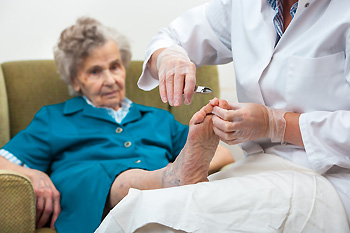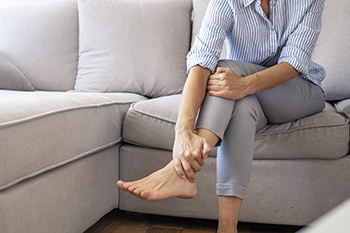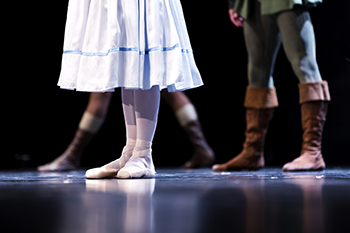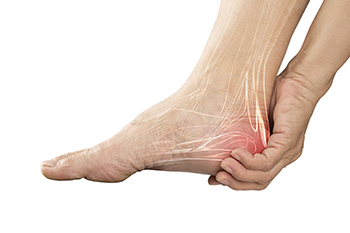Connect With Us
Blog

As we age, changes in circulation, skin health, and nerve function can increase the risk of foot problems. Regular foot exams help detect issues early, such as skin breakdown, poor circulation, deformities, or loss of sensation. These changes can lead to serious complications if not addressed promptly. During a foot exam, a podiatrist checks for signs of corns, calluses, ulcers, nail disorders, and circulation problems. They also assess for conditions like neuropathy, arthritis, or balance issues that can affect mobility and increase the risk of falls. Routine foot care and exams are an important part of staying active and independent. Older adults with diabetes, vascular disease, or difficulty trimming their nails benefit especially from regular professional care. If you or a loved one are experiencing foot discomfort or mobility issues, it is suggested that you schedule an appointment with a podiatrist to ensure early diagnosis and proper treatment.
If you need your feet checked, contact one of our podiatrists of Comprehensive Foot & Ankle Centers. Our doctors will attend to all of your foot and ankle needs and provide you with quality treatment.
Geriatrics and Podiatry
When people age, some common issues that may occur are bone density loss, dry skin, poor circulation, and rough brittle nails. These issues may also affect your foot health if the necessary steps are not taken to alleviate the problems.
It is important to take care of your feet because feet that are injured or diseased can affect your overall health. Having painful feet hinders your ability to do daily activities or may decrease your willingness to do the things that you need to do.
Visiting Your Geriatrician
As we age, health problems become more likely, so it is essential to visit your doctor for check-ups to ensure that you are doing the best you can to take care of your health. It is recommended to check your feet frequently for any possible cuts, bruises, swelling, corns or any other irregularities.
Taking Care of Elderly Feet
Cracked or dry feet can be treated by applying moisturizer often. It is also important not to wear old socks because the older the sock is, the higher the possibility there will be that there is bacteria there. Wear fresh socks and make sure they fit properly.
Proper foot health means that you can have a more active lifestyle and you will not be bogged down by pain. Foot health also leads to good circulation, which is paramount for overall health.
If you have any questions, please feel free to contact our offices located in Shepherdsville and Louisville, KY . We offer the newest diagnostic tools and technology to treat your foot and ankle needs.

Osteoarthritis in the foot occurs when the protective cartilage in the joints wears down over time, leading to pain, stiffness, and swelling. It is especially common in the big toe joint, midfoot, and ankle. Everyday activities like walking or standing can become difficult, and symptoms often worsen with age or after previous injuries. Treatment focuses on reducing pain and maintaining mobility. Supportive footwear, custom orthotics, and targeted exercises can help relieve pressure on affected joints. Anti-inflammatory medication and corticosteroid injections may also reduce inflammation. In severe cases, joint fusion or joint replacement surgery might be considered. If you are experiencing persistent foot pain or stiffness, it is suggested that you schedule an appointment with a podiatrist for a thorough evaluation, proper diagnosis, and a personalized treatment plan.
Arthritis can be a difficult condition to live with. If you are seeking treatment, contact one of our podiatrists from Comprehensive Foot & Ankle Centers. Our doctors can provide the care you need to keep you pain-free and on your feet.
Arthritic Foot Care
Arthritis is a term that is commonly used to describe joint pain. The condition itself can occur to anyone of any age, race, or gender, and there are over 100 types of it. Nevertheless, arthritis is more commonly found in women compared to men, and it is also more prevalent in those who are overweight. The causes of arthritis vary depending on which type of arthritis you have. Osteoarthritis for example, is often caused by injury, while rheumatoid arthritis is caused by a misdirected immune system.
Symptoms
- Swelling
- Pain
- Stiffness
- Decreased Range of Motion
Arthritic symptoms range in severity, and they may come and go. Some symptoms stay the same for several years but could potentially get worse with time. Severe cases of arthritis can prevent its sufferers from performing daily activities and make walking difficult.
Risk Factors
- Occupation – Occupations requiring repetitive knee movements have been linked to osteoarthritis
- Obesity – Excess weight can contribute to osteoarthritis development
- Infection – Microbial agents can infect the joints and trigger arthritis
- Joint Injuries – Damage to joints may lead to osteoarthritis
- Age – Risk increases with age
- Gender –Most types are more common in women
- Genetics – Arthritis can be hereditary
If you suspect your arthritis is affecting your feet, it is crucial that you see a podiatrist immediately. Your doctor will be able to address your specific case and help you decide which treatment method is best for you.
If you have any questions, please feel free to contact our offices located in Shepherdsville and Louisville, KY . We offer the newest diagnostic and treatment technologies for all your foot care needs.

In the world of dance and sports, foot injuries are common, but manageable with the right care, and a skilled podiatrist plays a key role in recovery. Dancers are particularly vulnerable to conditions like stress fractures, tendonitis, and ankle sprains due to repetitive movements and intense physical demands. These injuries often result from overuse, improper technique, or wearing inadequate footwear. A podiatrist's expertise is invaluable in diagnosing these issues accurately and creating personalized treatment plans. They can offer specialized care, recommend rehabilitation strategies, and guide dancers through gentle stretching and strengthening exercises. If you have persistent pain or suspect an injury, it is suggested that you schedlule an appointment with a podiatrist. Their knowledge and experience ensure effective recovery, allowing you to return to dancing with confidence, while reducing the risk of future injuries.
Ankle and foot injuries are common among athletes and in many sports. They can be caused by several problems and may be potentially serious. If you are feeling pain or think you were injured in a sporting event or when exercising, consult with one of our podiatrists from Comprehensive Foot & Ankle Centers. Our doctors will assess your condition and provide you with quality foot and ankle treatment.
Common Injuries
The most common injuries that occur in sporting activities include:
- Achilles Tendonitis
- Achilles Tendon Rupture
- Ankle Sprains
- Broken Foot
- Plantar Fasciitis
- Stress Fractures
- Turf Toe
Symptoms
Symptoms vary depending upon the injury and in some cases, there may be no symptoms at all. However, in most cases, some form of symptom is experienced. Pain, aching, burning, bruising, tenderness, tightness or stiffness, sensation loss, difficulty moving, and swelling are the most common symptoms.
Treatment
Just as symptoms vary depending upon the injury, so do treatment options. A common treatment method is known as the RICE method. This method involves rest, applying ice, compression and elevating the afflicted foot or ankle. If the injury appears to be more serious, surgery might be required, such as arthroscopic or reconstructive surgery. Lastly, rehabilitation or therapy might be needed to gain full functionality in the afflicted area. Any discomfort experienced by an athlete must be evaluated by a licensed, reputable medical professional.
If you have any questions, please feel free to contact our offices located in Shepherdsville and Louisville, KY . We offer the newest diagnostic and treatment technologies for all your foot care needs.

Heel spurs and plantar fasciitis are common causes of heel pain, but they are distinct conditions. A heel spur is a bony growth that develops on the heel bone due to prolonged strain on the foot muscles and ligaments. It often forms in response to repeated stress, but it does not always cause pain. Plantar fasciitis, on the other hand, is inflammation of the plantar fascia, a thick band of tissue that runs along the bottom of the foot. It results in sharp pain, especially in the morning or after long periods of rest. While heel spurs can be present in individuals with plantar fasciitis, they do not always contribute to discomfort. If you have heel pain, it is suggested that you consult a podiatrist who can accurately diagnose either condition, and guide you toward appropriate treatment solutions.
Many people suffer from bouts of heel pain. For more information, contact one of our podiatrists of Comprehensive Foot & Ankle Centers. Our doctors can provide the care you need to keep you pain-free and on your feet.
Causes of Heel Pain
Heel pain is often associated with plantar fasciitis. The plantar fascia is a band of tissues that extends along the bottom of the foot. A rip or tear in this ligament can cause inflammation of the tissue.
Achilles tendonitis is another cause of heel pain. Inflammation of the Achilles tendon will cause pain from fractures and muscle tearing. Lack of flexibility is also another symptom.
Heel spurs are another cause of pain. When the tissues of the plantar fascia undergo a great deal of stress, it can lead to ligament separation from the heel bone, causing heel spurs.
Why Might Heel Pain Occur?
- Wearing ill-fitting shoes
- Wearing non-supportive shoes
- Weight change
- Excessive running
Treatments
Heel pain should be treated as soon as possible for immediate results. Keeping your feet in a stress-free environment will help. If you suffer from Achilles tendonitis or plantar fasciitis, applying ice will reduce the swelling. Stretching before an exercise like running will help the muscles. Using all these tips will help make heel pain a condition of the past.
If you have any questions please contact our offices located in Shepherdsville and Louisville, KY . We offer the newest diagnostic and treatment technologies for all your foot and ankle needs.
Blog Archives
- April 2025
- March 2025
- February 2025
- January 2025
- December 2024
- November 2024
- October 2024
- September 2024
- August 2024
- July 2024
- June 2024
- May 2024
- April 2024
- March 2024
- February 2024
- January 2024
- December 2023
- November 2023
- October 2023
- September 2023
- August 2023
- July 2023
- June 2023
- May 2023
- April 2023
- March 2023
- February 2023
- January 2023
- December 2022
- November 2022
- October 2022
- September 2022
- August 2022
- July 2022
- June 2022
- May 2022
- April 2022
- March 2022
- February 2022
- January 2022
- December 2021
- November 2021
- October 2021
- September 2021
- August 2021
- July 2021
- June 2021
- May 2021
- April 2021
- March 2021
- February 2021
- January 2021
- December 2020
